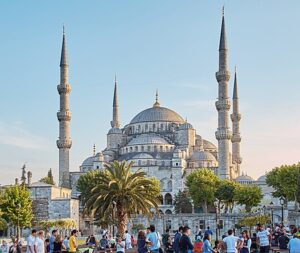The Blue Mosque in Istanbul is a favorite historical place , also known by its official name, the Sultan Ahmed Mosque (Turkish: Sultan Ahmet Camii), is an Ottoman-era historical imperial mosque located in Istanbul, Turkey. It was constructed between 1609 and 1617 during the rule of Ahmed I and this historical place remains a functioning mosque today. It also attracts a large number of tourists and is one of the most iconic historical place and popular monuments of Ottoman architecture.
The mosque has a classical Ottoman layout with a central dome surrounded by four semi-domes over the prayer hall. It is fronted by a large courtyard and flanked by six minarets. On the inside, it is decorated with thousands of Iznik tiles and painted floral motifs in predominantly blue colours, which give the mosque its popular name. The mosque’s külliye (religious complex) includes Ahmed’s tomb, a madrasa, and several other buildings in various states of preservation.
The mosque was built next to the former Hippodrome and stands across from the Hagia Sophia, another popular tourist site. The Blue Mosque was included in the UNESCO World Heritage Site list in 1985 under the name of “Historic Areas of Istanbul“.
The mosque’s site is politically charged. Unlike other Ottoman imperial mosques, which were placed farther away from the city center to encourage urban development and to take advantage of Istanbul’s hilly topography, the Sultan Ahmet mosque is nestled in between the Hagia Sophia and the Byzantine Hippodrome near the Ottoman royal residence, Topkapı Palace. In fact, the choice of location caused some consternation since it required the demolition of quite a few established palaces owned by Ottoman ministers. But prestige outweighed the enormous cost in coin and real estate. Constructing large mosque complexes for the benefit of the public was part of the imperial tradition denoting a pious and benevolent ruler. Placing the mosque adjacent to the Hagia Sophia also signified the triumph of an Islamic monument over a converted Christian church, a matter of great concern even 150 years after the Ottoman conquest of Istanbul in 1453.

